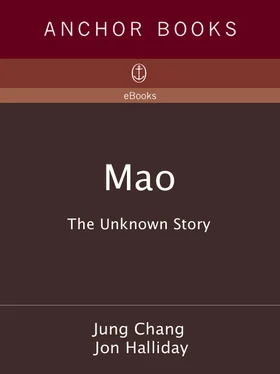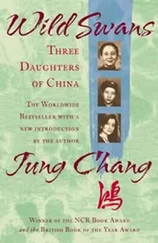At this time, warlords had been fighting sporadic wars for ten years, and there had been more than forty changes of the central government since the country had become a republic in 1912. But the warlords had always made sure that the social structure was preserved, and life went on as usual for civilians, as long as they were not caught in the crossfire. Now, because the Nationalists were following Russian instructions aimed at bringing about a Soviet-style revolution, social order broke down for the first time.
Violence erupted as poor peasants helped themselves to the food and money of the relatively rich, and took revenge. Thugs and sadists also indulged themselves. By December there was mayhem in the Hunan countryside. In his capacity as a leader of the peasant movement, Mao was invited back to his home province to give guidance.
CHANGSHA, WHEN MAO returned, was a changed city, with victims being paraded around in dunce’s hats (a European invention) as a sign of humiliation. Children scampered around singing “Down with the [imperialist] powers and eliminate the warlords,” the anthem of the Nationalist Revolution, sung to the tune of “Frère Jacques.”
On 20 December 1926 about 300 people crowded the Changsha slide-show theater to listen to Mao, who shared the stage with a Russian agitator called Boris Freyer. (Like virtually every Russian agent in China at this time, he later disappeared in Stalin’s purges.) Mao was no orator; his speech was two hours long, and flat. But it was moderate. “It is not the time yet to overthrow landlords,” he said. “We must make some concessions to them.” At the present stage, “we should only reduce rents and interest rates, and increase the wages of hired hands.” Quoting Mao as saying “we are not preparing to take the land immediately,” Freyer told the Russians’ control body, the Far Eastern Bureau, that Mao’s speech was basically “fine,” but inclined towards being too moderate.
Though Mao did not address the issue of violence, his general approach was not militant. Shortly afterwards he went off on an inspection tour of the Hunan countryside. By the end of the tour, which lasted thirty-two days, he had undergone a dramatic change. Mao himself was to say that before this trip he had been taking a moderate line, and “not until I stayed in Hunan for over thirty days did I completely change my attitude.” What really happened was that Mao discovered in himself a love for bloodthirsty thuggery. This gut enjoyment, which verged on sadism, meshed with, but preceded, his affinity for Leninist violence. Mao did not come to violence via theory. The propensity sprang from his character, and was to have a profound impact on his future methods of rule.
As he wrote in his report about his tour, Mao saw that grassroots peasant association bosses were mostly “ruffians,” activists who were the poorest and roughest, and who had been the most despised. Now they had power in their hands. They “have become lords and masters, and have turned the peasant associations into something quite terrifying in their hands,” he wrote. They chose their victims arbitrarily. “They coined the phrase: ‘Anyone who has land is a tyrant, and all gentry are bad.’ ” They “strike down the landlords to the ground, and stamp on them with their feet … they trample and romp on the ivory beds of the misses and madames. They seize people whenever they feel like it, put a high dunce’s hat on them, and parade them round. All in all, they thoroughly indulge every whim … and really have created terror in the countryside.”
Mao saw that the thugs loved to toy with victims and break down their dignity, as he described with approval:
A tall paper hat is put on [the victim], and on the hat is written landed tyrant so-and-so or bad gentry so-and-so. Then the person is pulled by a rope [like pulling an animal], followed by a big crowd … This punishment makes [victims] tremble most. After one such treatment, these people are forever broken …
The threat of uncertainty, and anguish, particularly appealed to him:
The peasant association is most clever. They seized a bad gentleman and declared that they were going to [do the above to] him … But then they decided not to do it that day … That bad gentleman did not know when he would be given this treatment, so every day he lived in anguish and never knew a moment’s peace.
Mao was very taken with one weapon, the suo-biao , a sharp, twin-edged knife with a long handle like a lance: “it … makes all landed tyrants and bad gentry tremble at the sight of it. The Hunan revolutionary authorities should … make sure every young and middle-aged male has one. There should be no limit put on [the use of] it.”
Mao saw and heard much about brutality, and he liked it. In the report he wrote afterwards, in March 1927, he said he felt “a kind of ecstasy never experienced before.” His descriptions of the brutality oozed excitement, and flowed with an adrenalin rush. “It is wonderful! It is wonderful!” he exulted.
Mao was told that people had been beaten to death. When asked what to do — and for the first time the life and death of people hung on one word of his — he said: “One or two beaten to death, no big deal.” Immediately after his visit, a rally was held in the village, at which another man, who was accused of opposing the peasant association, was savagely killed.
Before Mao arrived, there had been attempts by the leaders of the peasant movement in Hunan to bring down the level of violence, and they had detained some of those who had perpetrated atrocities. Now Mao ordered the detainees to be released. A revolution was not like a dinner party, he admonished the locals; it needed violence. “It is necessary to bring about a … reign of terror in every county.” Hunan’s peasant leaders obeyed.
Mao did not once address the issue that concerned peasants most, which was land redistribution. There was actually an urgent need for leadership, as some peasant associations had already begun doing their own redistribution, by moving boundary markers and burning land leases. People put forward various specific proposals. Not Mao. All he said at a Nationalist land committee meeting discussing this issue on 12 April was: “Confiscation of land boils down to not paying rent. There is no need for anything else.”
What fascinated Mao was violence that smashed the social order. And it was this propensity that caught Moscow’s eye, as it fitted into the Soviet model of a social revolution. Mao was now published for the first time in the Comintern journal, which ran his Hunan report (though without his name on it). He had shown that although he was ideologically shaky, his instincts were those of a Leninist. Some other Communists — especially the Party leader Professor Chen, who flew into a rage when he heard about mob atrocities and insisted that they had to be reined in — were ultimately not Communists of the Soviet type. Now, more than two years after casting him out, the CCP readmitted Mao into the leading circle. In April 1927 he was restored to the Central Committee, though only into the second tier without a vote (called an alternate member).
Mao was based at this time in the city of Wuhan, on the Yangtze, some 300 km northeast of Changsha, where he had moved from Canton with the Nationalist headquarters as the Nationalist army pushed north. Now even more prominent among the Nationalists as an overseer of the peasant movement, he stepped up the training of rural agitators so that they spread his violent line to new areas taken by the army. One text that Mao selected to guide his trainees described peasant association activists discussing ways to deal with their victims. If they were “stubborn,” “we’ll slit their ankle tendons and cut off their ears.” The author greeted the punishments, in particular this gruesome one, with rapture: “I had been listening so absorbedly as if in a drunken stupor or trance. Now I was suddenly woken up by the yelling of ‘Wonderful,’ and I too couldn’t help bursting out ‘Wonderful!’ ” This account was extraordinarily similar to Mao’s own report, both in style and language, and was most likely written by Mao himself.
Читать дальше










